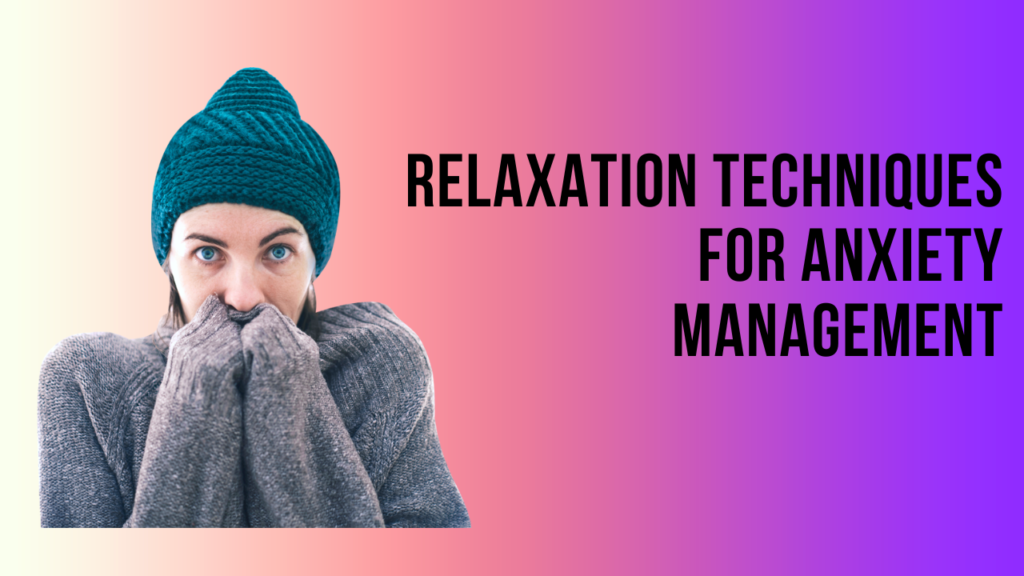
Anxiety is a common mental health issue affecting millions of people worldwide. It can be debilitating and interfere with your daily life, work, and relationships. Anxiety can also affect your ability to achieve success in various aspects of your life, such as work, education, and personal goals. Therefore, it is essential to learn relaxation techniques for anxiety that can help you manage anxiety and achieve success.
What is Anxiety?
Anxiety is a feeling of worry, nervousness, and unease. It can be mild or severe.
It’s normal to feel anxious occasionally – it’s part of being human! But if your anxiety is getting in the way of your day-to-day life, then it may be worth talking to someone about it. Anxiety disorders are very common and affect people in different ways: some people might have one specific type of anxiety disorder (such as panic disorder), while others will have more than one type at once (for example, both generalized anxiety disorder and social phobia).
What Causes Anxiety?
There are many different causes of anxiety. Stress, genetics, and lifestyle can all contribute to the development of an anxiety disorder. Underlying medical conditions such as depression or thyroid problems may also be responsible for your symptoms.
The good news is that many different treatment options are available for people with anxiety disorders, and they can be very effective at helping you cope with your symptoms so that you can live a happier life!
Why Learning Relaxation Techniques for Anxiety is Important?
Learning relaxation techniques for anxiety is essential since anxiety may greatly influence your mental and physical health. Anxiety can induce various symptoms, such as racing thoughts, elevated heart rate, sweating, and muscle tightness, all of which can harm your quality of life.
You can trigger your body’s natural relaxation response by practicing relaxation techniques for anxiety, which can combat the physical and mental symptoms of worry. Regular relaxation practice can help lower anxiety symptoms’ severity and frequency while improving your general sense of well-being.
In addition, relaxation techniques can be useful in managing other mental health conditions, such as depression, post-traumatic stress disorder (PTSD), and chronic pain. They can also help you cope with daily stressors and improve your ability to focus and concentrate.
Learning and practicing relaxation techniques can also empower you to manage your mental health and well-being actively. By incorporating relaxation techniques into your daily routine, you can cultivate a sense of inner calm and resilience that can help you navigate the ups and downs of life with greater ease and calmness.
What Are Relaxation Techniques for Anxiety?
Relaxation techniques for anxiety are a great way to get your mind and body in a relaxed state. They can be used as part of a daily routine or when you feel stressed out or anxious.
There are many different types of relaxation techniques for anxiety that work for different people, but here are some common ones:
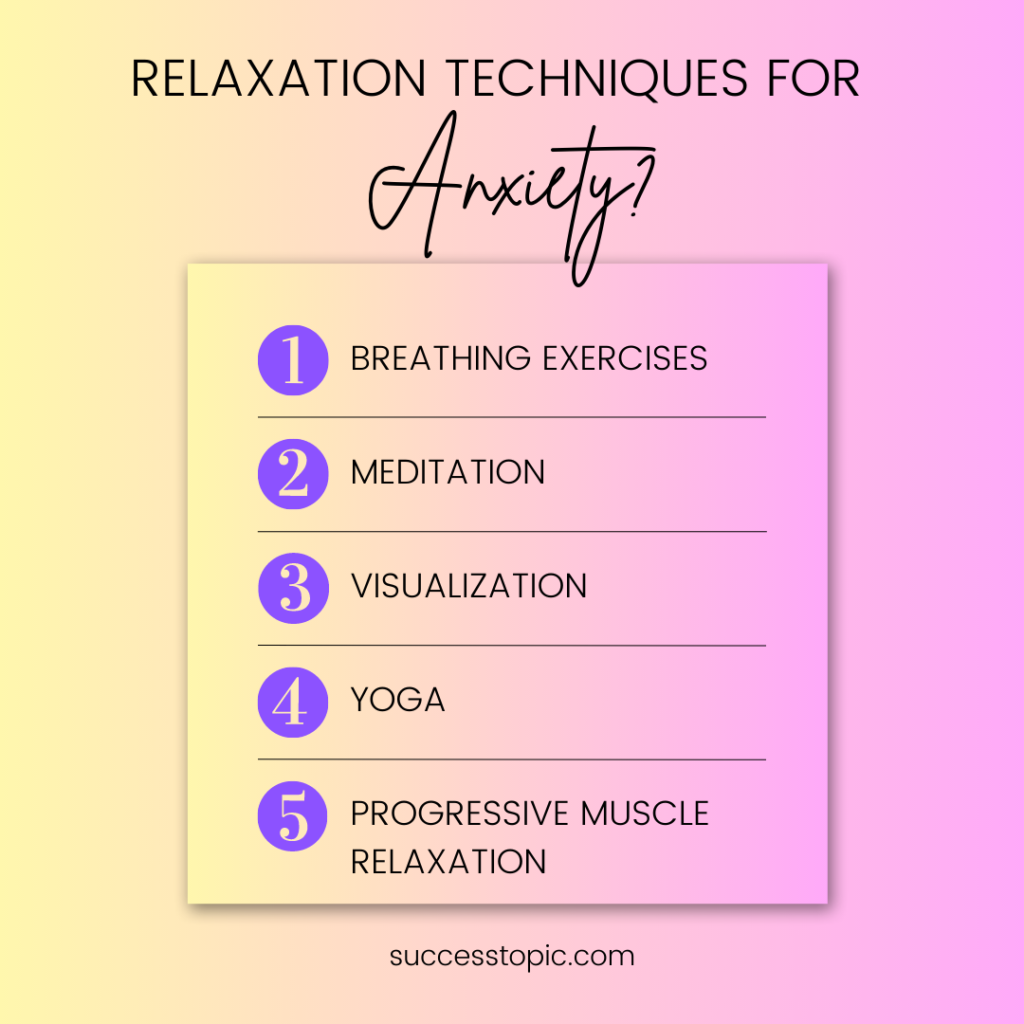
What are the different types of Breathing exercises?
Breathing deeply helps calm the nervous system and reduce stress hormones. Breathing techniques effectively reduce stress and anxiety and improve overall well-being. There are various types of breathing techniques, each with its own benefits. Some of the most popular breathing techniques include:
Pursed lip breathing
This technique involves inhaling through the nose and exhaling slowly through pursed lips. This technique can help relieve shortness of breath, especially in people with lung conditions like emphysema and chronic obstructive pulmonary disease (COPD).
Belly breathing
Also known as diaphragmatic breathing involves inhaling deeply through the nose and allowing the belly to expand, followed by exhaling slowly through the mouth. These relaxation techniques for anxiety can help reduce stress and anxiety by slowing down the heart rate and relaxing the muscles.
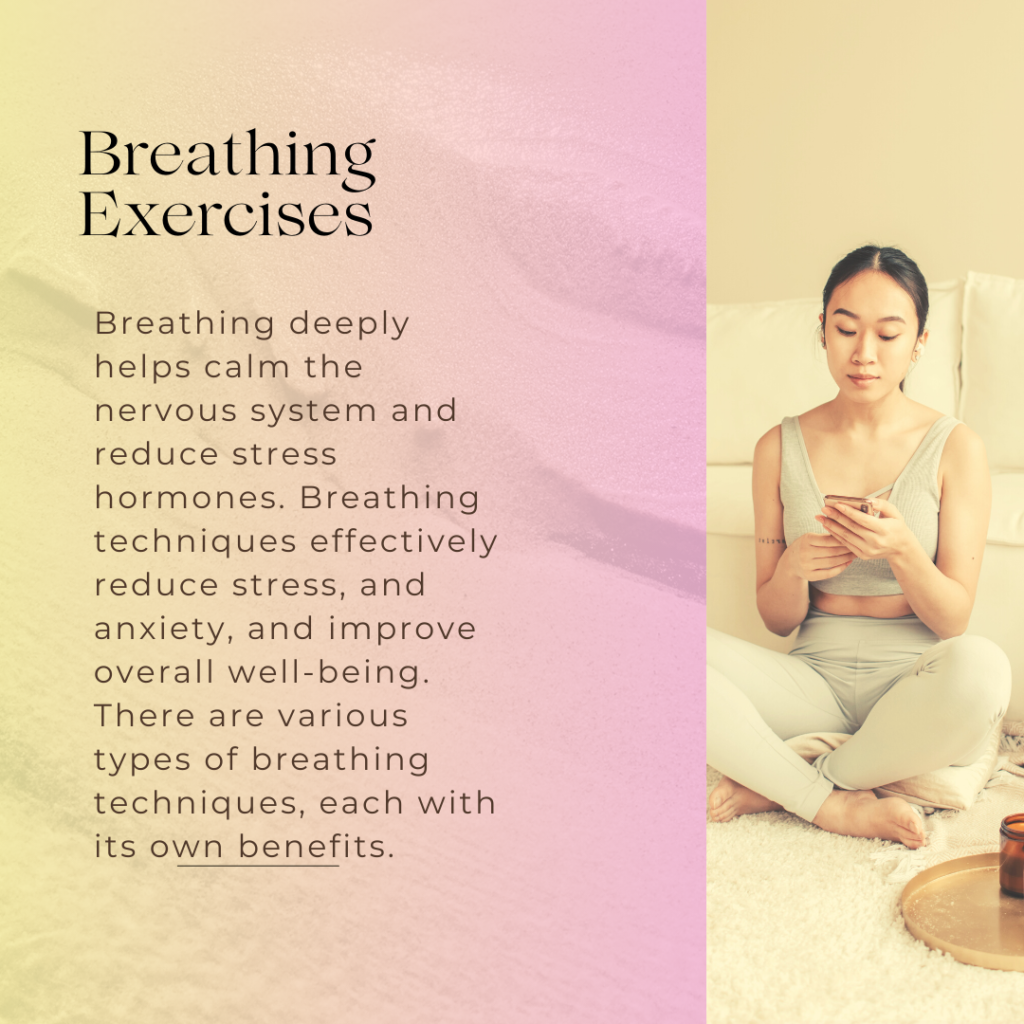
Breath focus
This technique involves focusing on your breath and counting each inhales and exhale. This can help improve concentration and reduce stress.
Lion’s breath
This technique involves inhaling deeply through the nose and exhaling forcefully through the mouth while sticking out your tongue. This technique can help relieve tension in the face and throat and reduce stress.
Alternate nostril breathing
This technique involves closing one nostril with your finger and inhaling through the other nostril, then closing that nostril and exhaling through the opposite nostril. This technique can help calm the mind and improve overall well-being.
Equal breathing
This technique involves inhaling and exhaling through the nose for the same length of time. This technique can help improve focus and concentration.
Resonant breathing
This technique involves inhaling for a count of 4, holding the breath for a count of 7, and exhaling for a count of 8. This technique can help reduce stress and anxiety.
Sitali breathing
This technique involves inhaling through the mouth and exhaling through the nose while making a “shh” sound. This technique can help reduce stress and cool down the body.
Mindful breathing
This technique involves finding a quiet place without distractions, choosing a comfortable position (ideally sitting or lying down), and focusing on breathing by feeling and listening. This technique can help reduce stress and improve overall well-being.
Deep breathing
Also known as yogic breathing involves using the diaphragm to increase the inflow and outflow of air and decrease the frequency of each breathing cycle. This technique can help reduce stress and anxiety and improve overall well-being.
Progressive muscle relaxation
Progressive Muscle Relaxation (PMR) is a relaxation technique that can help alleviate anxiety symptoms such as muscle tension and shortness of breath. PMR is especially helpful in moments of high stress or nervousness. Research shows that PMR can help control the anxiety response.
PMR involves tensing and then relaxing various muscle groups in the body, which can help reduce muscle tension and chronic pain, improve focus and mood, and improve sleep quality
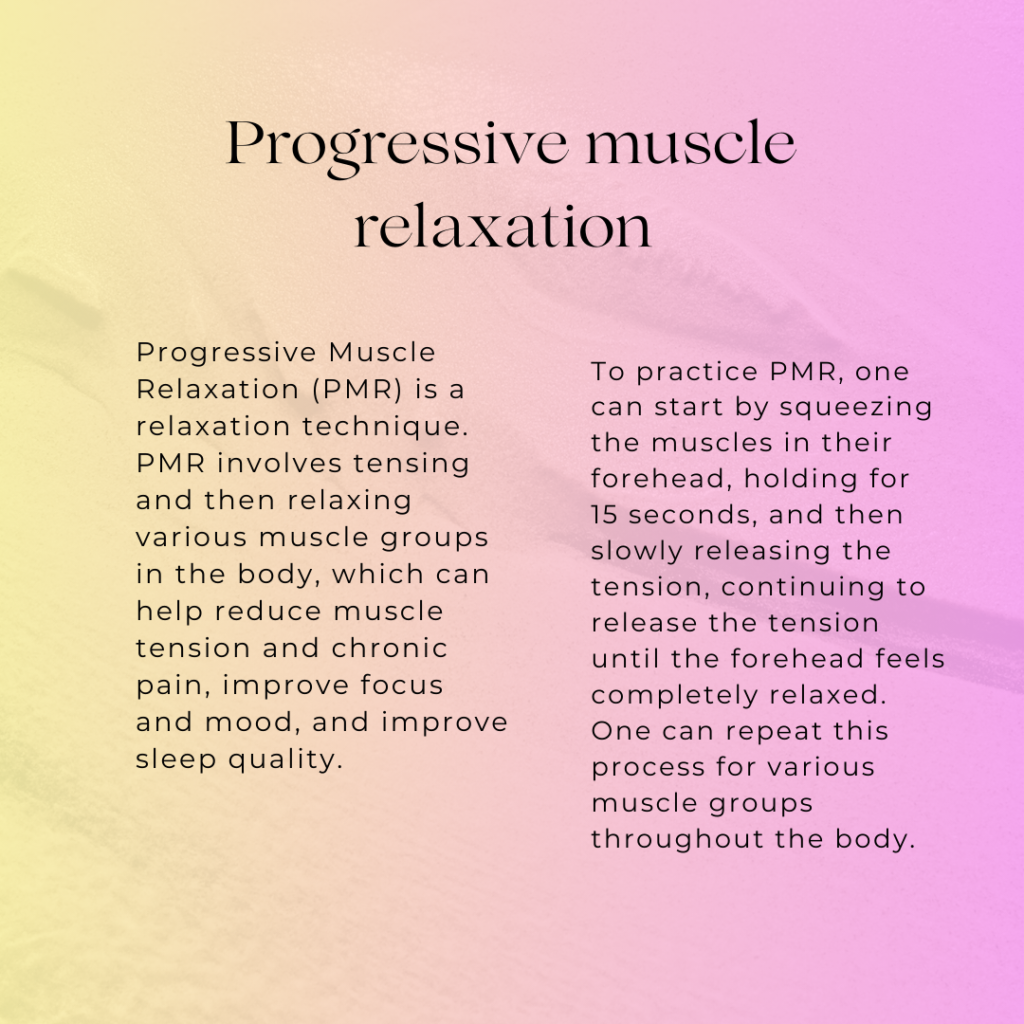
To practice PMR, one can start by squeezing the muscles in their forehead, holding for 15 seconds, and then slowly releasing the tension, continuing to release the tension until the forehead feels completely relaxed. One can repeat this process for various muscle groups throughout the body.
How to perform PMR?
Here are the steps for practicing PMR:
- Find a comfortable and quiet place to practice PMR.
- Sit or lie down and close your eyes.
- Take a few deep breaths and focus on your breathing.
- Starting with your feet, tense the muscles in that area by squeezing them tightly for a few seconds. Hold the tension for a few seconds, then release and let the muscles relax completely.
- Move up to your calves and repeat the same process of tensing and relaxing.
- Continue to work your way up your body, tensing and relaxing the muscles in your thighs, buttocks, stomach, chest, back, shoulders, arms, hands, neck, and face.
- As you tense each muscle group, focus on the sensation of the tension and then release it completely, feeling the relaxation spread through your body.
- Once you have completed the whole body, take a few deep breaths and allow yourself to relax for a few moments before opening your eyes.
Mindfulness meditation
Mindfulness meditation can be an effective way to manage feelings of stress and anxiety. It can even be used as a relaxation technique for panic disorder. Mindfulness meditation is a type of meditation that involves focusing on the present moment without judgment. This technique can help you reduce anxiety and improve your ability to focus and achieve success.
Research across age groups, gender, and geographical locations have found that practicing mindfulness meditation can help individuals slow down racing thoughts, decrease negativity, and calm both the mind and body. Various mindfulness exercises can be practiced to alleviate anxiety. For instance, the RAIN meditation is a popular mindfulness exercise that can be used to manage anxiety. It involves recognizing, accepting, investigating, and nurturing emotions.
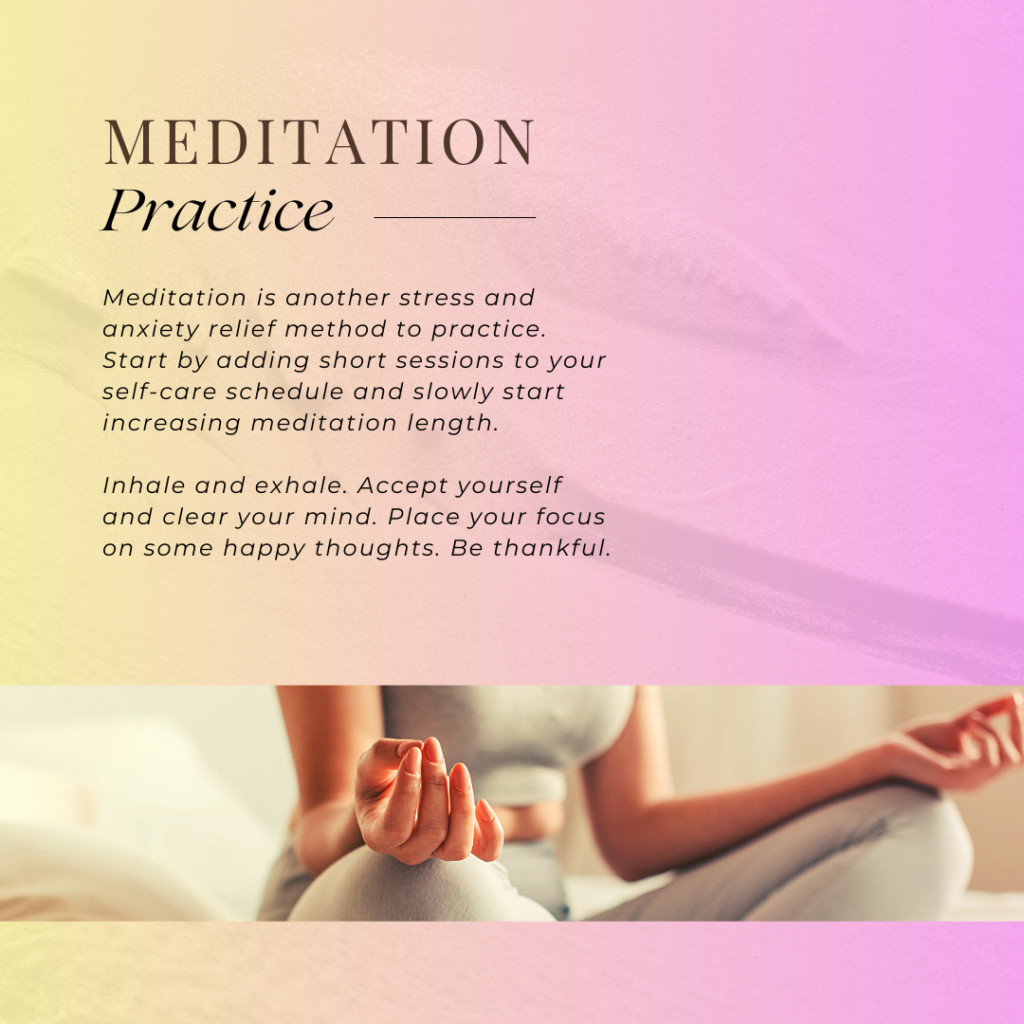
Other mindfulness exercises that can help alleviate anxiety include focusing on the breath, body scan meditation, and walking meditation. These exercises can help individuals become more aware of the present moment, reduce negative thoughts, and improve their ability to regulate emotions.
Here’s how to do it:
- Find a quiet place to sit or lie down, close your eyes, and take a few deep breaths.
- Focus your attention on your breath and the sensation of air moving in and out of your body.
- If your mind wanders, gently bring your attention back to your breath.
- Practice mindfulness meditation for several minutes each day, gradually increasing the duration as you become more comfortable with the practice.
Visualization
Visualization is a powerful technique that can help relieve the symptoms of anxiety . It involves using mental imagery to achieve a more relaxed state of mind. Visualization is similar to daydreaming and is accomplished through the use of your imagination.
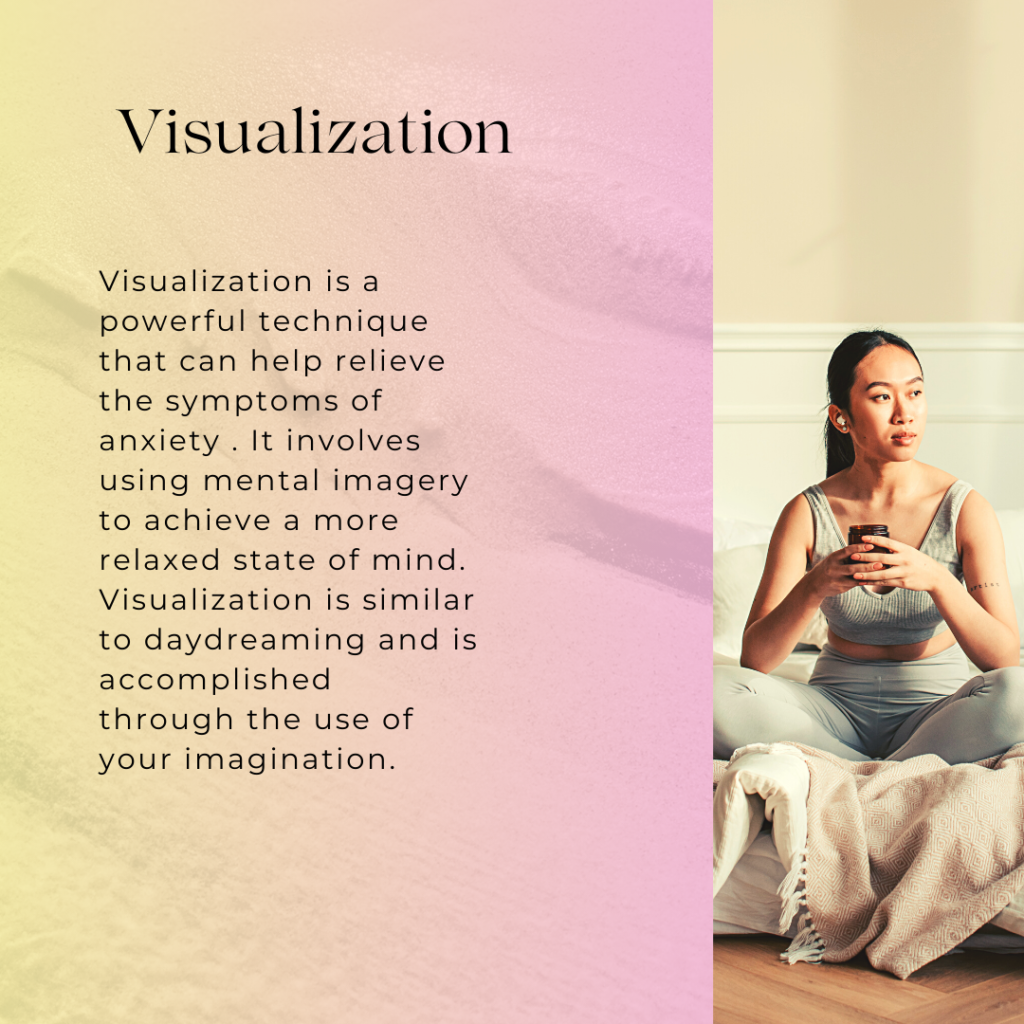
There are various visualization techniques that can be used to reduce anxiety, such as guided imagery, color visualization, and peaceful place visualization. Visualization can be quite a powerful technique when used correctly and can stop anxiety cycles in their tracks and decrease stress levels. It is a distraction technique that forces your mind to focus on soothing mental imagery instead of the stresses or fears of the present
Here’s how to do it:
- Find a quiet place to sit or lie down, close your eyes, and take a few deep breaths.
- Imagine a peaceful, relaxing scene, such as a beach, a forest, or a mountain.
- Visualize yourself in this scene, enjoying the sights, sounds, and sensations.
- Stay in this visualization for several minutes, focusing on the feeling of relaxation and calm.
Yoga
Yoga is an ancient Indian practice that has gained popularity worldwide for its physical and mental health benefits. It combines physical postures (asanas), breath control (pranayama), and meditation or relaxation techniques.
Yoga has been demonstrated to improve physical strength, flexibility, and balance and alleviate stress, anxiety, and sadness. It can also help with sleep quality and general well-being. Yoga comes in various styles, each with its own distinct approach and focus. Hatha, Vinyasa, Bikram, and Restorative yoga are some popular styles. It’s critical to choose a teaching style and teacher who are a good fit for you and your goals.
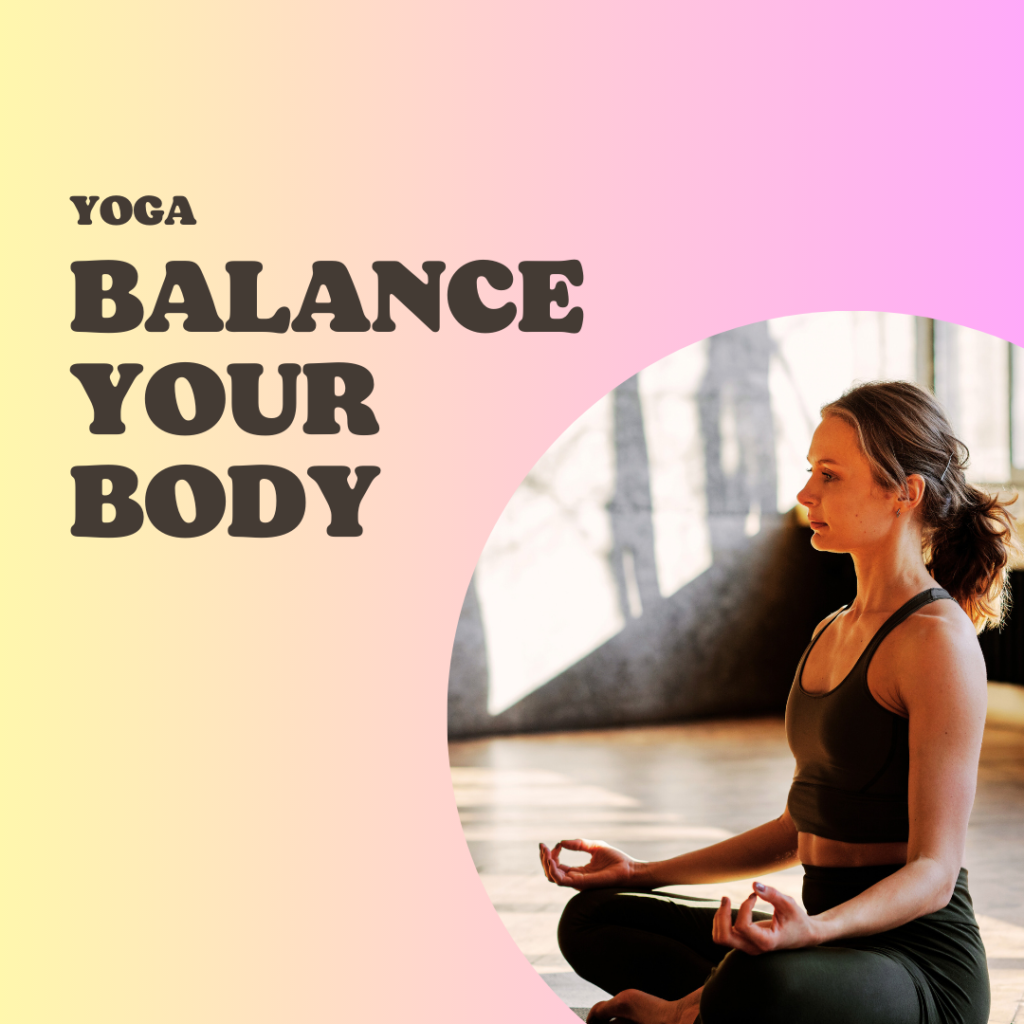
Yoga can be an effective relaxation technique for anxiety. Yoga can be practised at home or with a teacher in a studio. It is critical to pay attention to your body. A systematic review of multiple studies found that practicing yoga can significantly reduce anxiety symptoms in adults.
Healthline recommends trying poses such as Hero pose, Tree pose, Triangle pose, Standing Forward Bend, Fish pose, Extended Puppy pose, Child’s pose, Head-to-Knee Forward Bend, Seated Forward Bend, and Corpse pose for anxiety relief.
Psych Central also suggests a yoga sequence for anxiety relief, including poses that focus on releasing tension in the neck and shoulders. Furthermore, practicing deep breathing and meditation along with yoga poses to calm anxiety.
Benefits of Relaxation Techniques for Anxiety
The benefits of relaxation techniques for anxiety are many. They include:
Relaxation techniques can have a significant positive impact on managing anxiety and improving overall mental health. The benefits of practicing relaxation techniques for anxiety include the following:
Reduced stress levels
Relaxation techniques help lower stress hormones like cortisol, resulting in a more balanced state of mind and reduced feelings of anxiety.
Improved focus and concentration
By calming the mind, relaxation techniques can enhance focus and concentration, making it easier to manage daily tasks and perform better professionally and personally.
Better sleep quality
Anxiety often leads to sleep disturbances. Relaxation techniques for anxiety can improve sleep quality by promoting a sense of calm and relaxation before bedtime.
Enhanced emotional regulation
Practicing relaxation techniques for anxiety can help individuals develop better emotional regulation, allowing them to handle stress and anxiety more effectively.
Lower blood pressure and heart rate
By reducing stress levels, relaxation techniques for anxiety can also contribute to lowering blood pressure and heart rate, improving overall cardiovascular health.
Increased self-awareness
Relaxation techniques often involve mindfulness, which can help individuals become more aware of their thoughts, emotions, and bodily sensations. This increased self-awareness can help in identifying anxiety triggers and managing them more effectively.
Strengthened immune system
Chronic stress and anxiety can weaken the immune system. Relaxation techniques can help boost immunity by reducing stress and promoting overall well-being.
Improved coping skills
Regular practice of relaxation techniques can help individuals develop better coping skills to deal with stressful situations, reducing the impact of anxiety on their lives.
Greater sense of well-being
Incorporating relaxation techniques into daily life can lead to a greater sense of well-being and happiness, helping to combat anxiety and promote overall mental health.
Wrap up
In conclusion, anxiety can be challenging to manage, but with the right relaxation techniques for anxiety, it is possible to reduce anxiety and achieve success. Try these techniques regularly to improve your mental and physical health and achieve your goals.
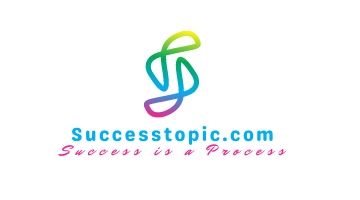
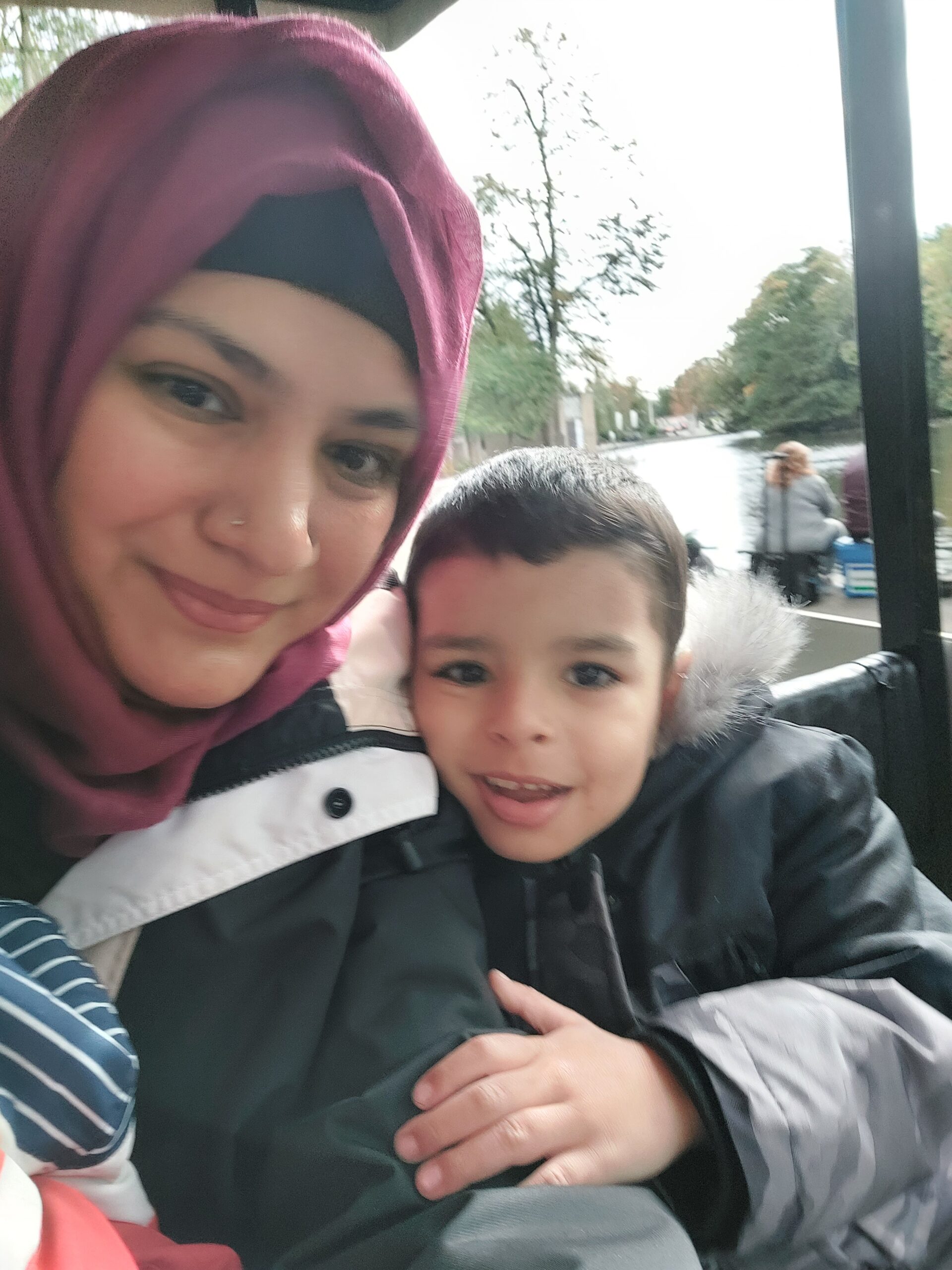
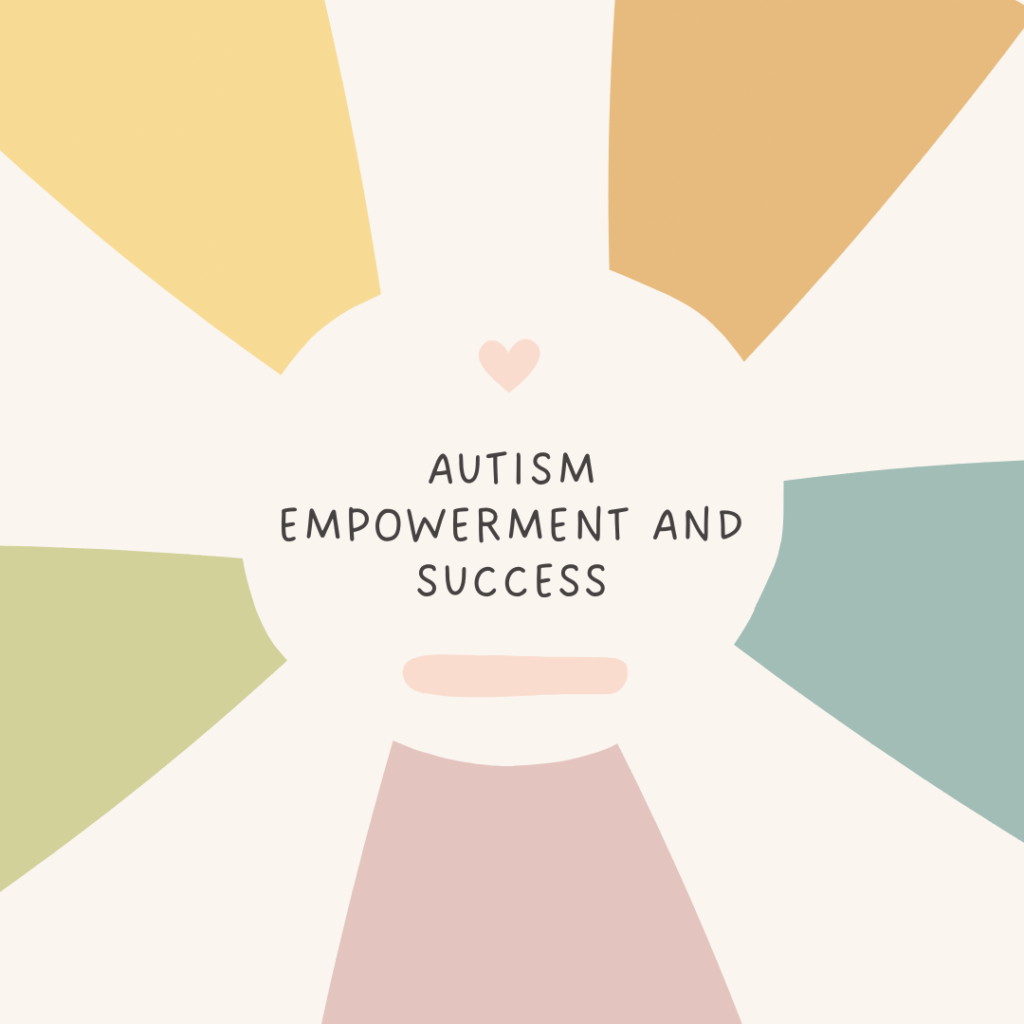
One thought on “What are the Relaxation Techniques For Anxiety Management”